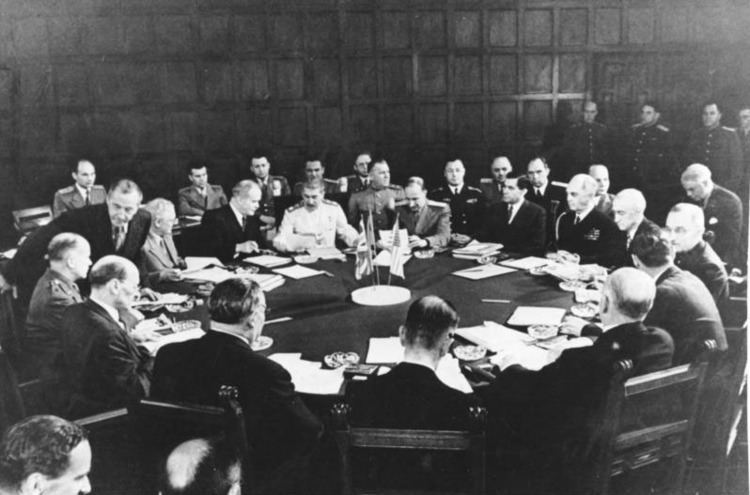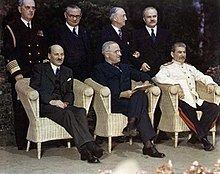Dates 17 Jul 1945 – 2 Aug 1945 | ||
 | ||
Similar Yalta Conference, Casablanca Conference, Tehran Conference | ||
The potsdam conference when the cold war began
The Potsdam Conference (German: Potsdamer Konferenz) was held at Cecilienhof, the home of Crown Prince Wilhelm, in Potsdam, occupied Germany, from 17 July to 2 August 1945. (In some older documents it is also referred to as the Berlin Conference of the Three Heads of Government of the USSR, USA and UK.) Participants were the Soviet Union, the United Kingdom and the United States. The three powers were represented by Communist Party General Secretary Joseph Stalin, Prime Ministers Winston Churchill and, later, Clement Attlee, and President Harry S. Truman.
Contents
- The potsdam conference when the cold war began
- Lesson 9 the yalta conference and the potsdam conference us diplomacy
- Relationships amongst the leaders
- Potsdam Agreements
- Indochina
- Germany
- Poland
- Potsdam Declaration
- Aftermath
- Previous major conferences
- References

Stalin, Churchill, and Truman—as well as Attlee, who participated alongside Churchill while awaiting the outcome of the 1945 general election, and then replaced Churchill as Prime Minister after the Labour Party's defeat of the Conservatives—gathered to decide how to administer the defeated Nazi Germany, which had agreed to unconditional surrender nine weeks earlier, on 8 May (V-E Day). The goals of the conference also included the establishment of post-war order, peace treaty issues, and countering the effects of the war.
Lesson 9 the yalta conference and the potsdam conference us diplomacy
Relationships amongst the leaders

In the five months since the Yalta Conference, a number of changes had taken place which would greatly affect the relationships between the leaders.

Firstly, the Soviet Union was occupying Central and Eastern Europe. By July, the Red Army effectively controlled the Baltic states, Poland, Czechoslovakia, Hungary, Bulgaria and Romania, and fearing a Stalinist take-over, refugees were fleeing from these countries. Stalin had set up a communist government in Poland. He insisted that his control of Eastern Europe was a defensive measure against possible future attacks and claimed that it was a legitimate sphere of Soviet influence.

Secondly, Britain had a new Prime Minister. Before VE Day, Conservative Party leader Winston Churchill had served as Prime Minister in a coalition government; his Soviet policy since the early 1940s had differed considerably from former US President Roosevelt's, with Churchill believing Stalin to be a "devil"-like tyrant leading a vile system. A general election was held in the UK on 5 July, the results of which became known during the conference: with a Labour Party majority, Labour leader Clement Attlee became the new Prime Minister.
Thirdly, President Roosevelt had died on 12 April 1945, and Vice-President Harry Truman assumed the presidency by virtue of the 20th Amendment; his succession saw VE Day (Victory in Europe) within a month and VJ Day (Victory in Japan) on the horizon. During the war and in the name of Allied unity, Roosevelt had brushed off warnings of a potential domination by a Stalin dictatorship in part of Europe. He explained that "I just have a hunch that Stalin is not that kind of a man", and reasoned, "I think that if I give him everything I possibly can and ask for nothing from him in return, 'noblesse oblige', he won't try to annex anything and will work with me for a world of democracy and peace."
While inexperienced in foreign affairs, Truman had closely followed the allied progress of the war. George Lenczowski notes that "despite the contrast between his relatively modest background and the international glamour of his aristocratic predecessor, [Truman] had the courage and resolution to reverse the policy that appeared to him naive and dangerous", which was "in contrast to the immediate, often ad hoc moves and solutions dictated by the demands of the war". With the end of the war, the priority of allied unity was replaced with a new challenge, the nature of the relationship between the two emerging superpowers. The two leading powers continued to sustain a cordial relationship to the public but suspicions and distrust lingered between them. As the suspicion grew between the two rising powers, Stalin proposed that America will use their economical advantage and success in order to entices other nations into expanding their U.S. policies.
Truman became much more suspicious of communist moves than Roosevelt had been, and he became increasingly suspicious of Soviet intentions under Stalin. Truman and his advisers saw Soviet actions in Eastern Europe as aggressive expansionism which was incompatible with the agreements Stalin had committed to at Yalta the previous February. In addition, it was at the Potsdam Conference that Truman became aware of possible complications elsewhere, when Stalin objected to Churchill's proposal for an early Allied withdrawal from Iran, ahead of the schedule agreed at the Tehran Conference. However, the Potsdam Conference marks the first and only time Truman would ever meet Stalin in person.
Potsdam Agreements
At the end of the conference, the three Heads of Government agreed on the following actions. All other issues were to be answered by the final peace conference to be called as soon as possible.
Indochina
Allied Chiefs of Staff at the Potsdam Conference decided to temporarily partition Vietnam at the 16th parallel (just North of Da Nang) for the purposes of operational convenience.
It was agreed that British forces would take the surrender of Japanese forces in Saigon for the southern half of Indochina, whilst Japanese troops in the northern half would surrender to the Chinese.
Germany
Poland
Potsdam Declaration
In addition to the Potsdam Agreement, on 26 July, Churchill, Truman, and Chiang Kai-shek, Chairman of the Nationalist Government of China (the Soviet Union was not at war with Japan) issued the Potsdam Declaration which outlined the terms of surrender for Japan during World War II in Asia.
Aftermath
Truman had mentioned an unspecified "powerful new weapon" to Stalin during the conference. Towards the end of the conference, Japan was given an ultimatum to surrender (in the name of the United States, Great Britain and China) or meet "prompt and utter destruction", which did not mention the new bomb. Prime minister Kantarō Suzuki did not respond (mokusatsu, which was interpreted as a declaration that the Empire of Japan should ignore the ultimatum). Therefore, the United States dropped atomic bombs on Hiroshima on August 6 and Nagasaki on August 9, 1945. The justification was that both cities were legitimate military targets, to end the war swiftly, and preserve American lives. However, to some the timing has suggested that Truman did not want Stalin involved in the terms of Japan's surrender. It is important to note that Truman delayed the Potsdam Conference in order to be sure of the functionality of this "powerful new weapon". Notably, when Truman informed Stalin of the atomic bomb, he did not explicitly mention its atomic nature, just vaguely saying that the United States "had a new weapon of unusual destructive force"; Stalin, though, had full knowledge of the atomic bomb's development due to Soviet spy networks inside the Manhattan Project, and told Truman at the conference to "make good use of this new addition to the Allied arsenal".
The Soviet Union converted the other countries of eastern Europe into satellite states within the Eastern Bloc, such as the People's Republic of Poland, the People's Republic of Bulgaria, the People's Republic of Hungary, the Czechoslovak Republic, the People's Republic of Romania, and the People's Republic of Albania. The Soviets later formed the puppet state of East Germany (officially the German Democratic Republic) from the Soviet zone of German occupation.
